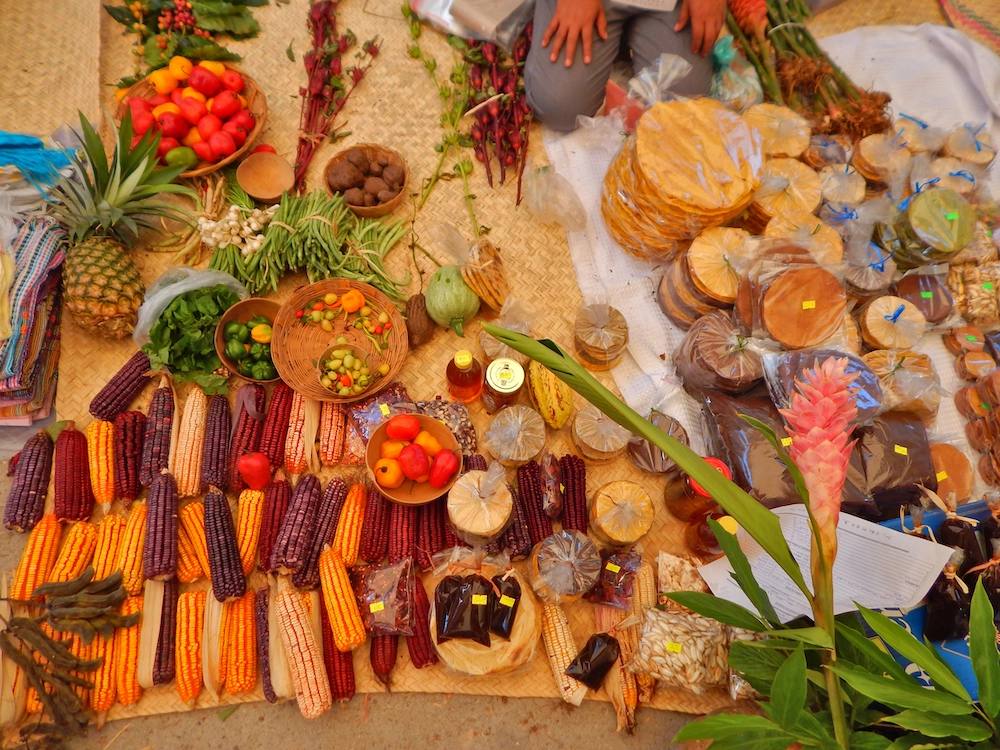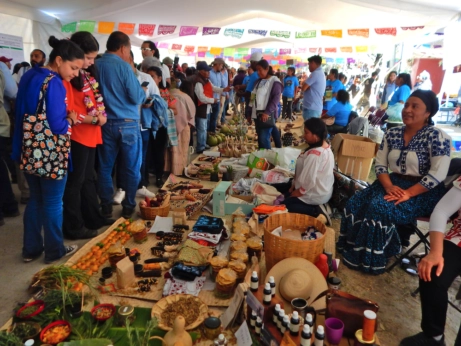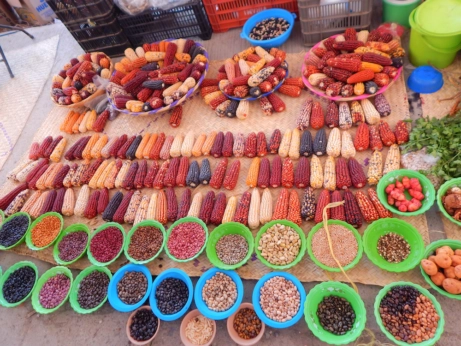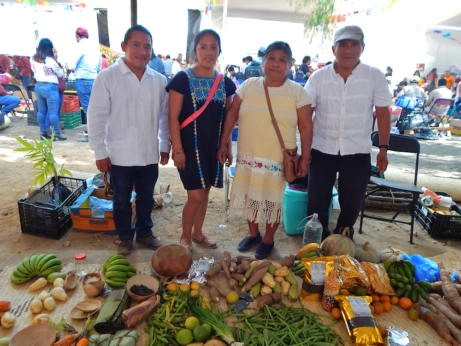In Oaxaca, a State Fair That Celebrates Native Crops’ Rich Legacy
At the much-anticipated annual agrobiodiversity fair, farmers preserve native crops by sharing seeds and showing off a bounty of corn and other culturally significant crops.
In Oaxaca, a State Fair That Celebrates Native Crops’ Rich Legacy
At the much-anticipated annual agrobiodiversity fair, farmers preserve native crops by sharing seeds and showing off a bounty of corn and other culturally significant crops.

Farmers from the coastal San Miguel del Puerto area display a wealth of crops ranging from corn to chiles to green beans.by Lauren Rothman.
Anyone who’s spent time in Mexico can report firsthand on the country’s deep reverence for corn, that infinitely versatile and nutritive grain that forms the base of the country’s daily bread, the tortilla, as well as a multitude of other traditional foods. Much more than just a crop, corn has been a fundamental part of Mexican life since time immemorial, with the Mayan sacred text the Popol Vuh relating that the creator gods Tepeu and Gucumatz formed the first human beings from maíz, as corn is known in Spanish.
Here in Oaxaca, the southwestern Mexican state known for rich cultural traditions ranging from intricate artisan goods to vibrant music and dance, the veneration for corn is apparent when surveying some of the area’s favorite foods. You might greet your day here with a steaming mug of atole, a sweetened corn gruel akin to a thinned-out porridge; enjoy a midmorning snack of memelas, thick corn tortillas swiped with pork lard and a variety of other toppings; and, at dinnertime, crunch into a tlayuda, an oversized tortilla stuffed with mozzarella-like quesillo cheese and griddled over hot coals until crisp. And if, for some reason, the Oaxacan adoration of corn wasn’t glaringly obvious, a stroll through the area’s yearly Feria Estatal de la Agrobiodiversidad—the state fair of agrobiodiversity—clears the matter up in no time.
This much-anticipated daylong event, which aims to both promote and protect Oaxaca’s agricultural richness, takes place every year in late November or early December. This year, the fair opened its doors on Saturday, December 2, in the community of San Pablo de Mitla, located about an hour’s drive east of the capital, Oaxaca City. A multisensory celebration of local crops ranging from sweet potatoes to medicinal herbs to amaranth, the Fería naturally has a heavy presence of corn. This year, visitors to the fair—who range from foodie members of the public to agronomy students to biologists and more—were greeted by an elaborate arch bedecked in multicolored corn kernels and flowerlike dried husks, with a mosaic-style image depicting a woman with long braids emerging from an ear of corn.

Passing through the archway, visitors arrived under a big white tent where more than 500 farmers from across the state and a handful from out of state displayed their colorful, edible wares. Sprawled out on the ground atop well-worn petates (woven-fiber mats) or seated on low stools, the farmers showed off their hard-earned ears of corn, yes, but also laid out carefully arranged piles of smooth, shiny beans, bowls of bright red and yellow chile peppers, verdant heaps of string beans and many more crops. This year, according to to the Secretaría de Fomento Agroalimentario y Desarrollo Rural—the governmental body that’s part of a multigroup organizing committee that puts the fair together—more than 500 expositors belonging to 16 indigenous ethnic groups were present, bringing with them 35 of Mexico’s 64 native variants of corn alongside other important crops.
In Mexico, as in the rest of the modern world, biologically diverse traditional agriculture is increasingly being crowded out by hybrid and genetically modified crops that can withstand heavy applications of industrial herbicides and pesticides. For many millennia, the land of the milpa—an interdependent, mutually beneficial growing system of corn, beans, squash and the class of wild-growing greens collectively known as quelites—the country, since the so-called Green Revolution of the 1950s and 60s, has increasingly shifted to vast, chemical-dependent monocultures of crops, including corn, limes, papaya and single-species forests grown for harvesting timber.

The idea for the Fería, now in its 11th year, was born as a response to this ecological crisis, which necessarily endangers the existence of small-scale traditional crops that are more time consuming to grow and less lucrative to sell, according to Girmey López Martínez, an agricultural engineer and promoter of traditional agriculture. Each year, the fair unites a diverse group of farmers who continue to grow traditional Oaxacan crops even in the face of the rising tide of big ag, sharing their products with the public in order to help maintain culinary familiarity with them, as well as saving seeds to exchange them with other farmers they meet at the fair in an additional effort to maintain agricultural diversity in the region.
“The aim of the fair is to strengthen and maintain the biodiversity of the region’s gardens, milpas, coffee plantations and cacao plantations,” said Martínez in an interview a few days after the most recent edition of the fair, which he helped fundraise. In addition to an increasing dependence on monocropping in Oaxaca, Martínez cited factors such as the growth of the local ranching industry and the explosion of unsustainable ecotourism practices as additional pressures that endanger agricultural diversity in the region.

For husband-and-wife producers José Gregorio Justo and Reina Ramirez Ronquillo from the rainforested Chinantla region of Oaxaca, continuing to grow the corn sown by their ancestors is of utmost importance. “We can’t lose the traditions we’ve had since the olden times,” Ronquillo said at the fair as she stood behind the couple’s abundant display of organically grown sugarcane, bananas, squashes, green beans, coffee, beans and several types of corn. “Where we live, lots of people are growing genetically modified corn. But we know that what we grow is better than that type of corn. And we’re taking care of the soil, too.”
Accompanied at her display by her daughter-in-law, Ronquillo added that farming in the old way takes future generations into consideration, too. “We don’t buy anything at the store,” she said. “Everything we eat, we grow. Lots of mothers and fathers today are buying their children sodas and chips, and it’s pure poison. Our grandchildren eat boiled chayotes, bananas, yucca; we make a fresh infused water to drink and it’s much healthier.”
Nearby, Maria de Jesús Fuentes attended to her display of panela, or raw sugar-sweetened tostadas made from native corn and flavored with additional ingredients such as cacao and grated coconut. Fuentes had traveled from the Mandimbo community close to the Oaxacan coast and, in addition to her prepared products, had in tow a variety of young fruit trees ranging from jackfruit to starfruit to mango. She explains that part of her work is saving the seeds from different types of fruit, both to trade with other farmers as well as to grow into trees that she sells.
“There are two major threats to criolla [native] seeds today,” said Fuentes. “One is the threat of all the GMO crops everyone is sowing. And the other is that the young people just don’t want to keep farming. Under both of these threats, species can go extinct. And that is why we save seeds.”

While many of the vendors adhere to organic practices, others continue to sow native crops but take advantage of the convenience offered by agrochemicals, such as one farmer from the mountainous La Cañada region who admitted to mixing commercial fertilizer in with goat manure.
Overall, Martínez noted, the majority of the expositors left this year’s fair feeling delighted with the event and the opportunity to exchange products, seeds and ideas with other growers as well as with the Oaxacan public. “This is our second year participating, and we really enjoy being here,” said Ronquillo from the Chinantla region. “It makes us happy to be able to offer the products that we grow.”
Follow us

This work is licensed under a Creative Commons Attribution-NoDerivatives 4.0 International License.
Want to republish a Modern Farmer story?
We are happy for Modern Farmer stories to be shared, and encourage you to republish our articles for your audience. When doing so, we ask that you follow these guidelines:
Please credit us and our writers
For the author byline, please use “Author Name, Modern Farmer.” At the top of our stories, if on the web, please include this text and link: “This story was originally published by Modern Farmer.”
Please make sure to include a link back to either our home page or the article URL.
At the bottom of the story, please include the following text:
“Modern Farmer is a nonprofit initiative dedicated to raising awareness and catalyzing action at the intersection of food, agriculture, and society. Read more at <link>Modern Farmer</link>.”
Use our widget
We’d like to be able to track our stories, so we ask that if you republish our content, you do so using our widget (located on the left hand side of the article). The HTML code has a built-in tracker that tells us the data and domain where the story was published, as well as view counts.
Check the image requirements
It’s your responsibility to confirm you're licensed to republish images in our articles. Some images, such as those from commercial providers, don't allow their images to be republished without permission or payment. Copyright terms are generally listed in the image caption and attribution. You are welcome to omit our images or substitute with your own. Charts and interactive graphics follow the same rules.
Don’t change too much. Or, ask us first.
Articles must be republished in their entirety. It’s okay to change references to time (“today” to “yesterday”) or location (“Iowa City, IA” to “here”). But please keep everything else the same.
If you feel strongly that a more material edit needs to be made, get in touch with us at [email protected]. We’re happy to discuss it with the original author, but we must have prior approval for changes before publication.
Special cases
Extracts. You may run the first few lines or paragraphs of the article and then say: “Read the full article at Modern Farmer” with a link back to the original article.
Quotes. You may quote authors provided you include a link back to the article URL.
Translations. These require writer approval. To inquire about translation of a Modern Farmer article, contact us at [email protected]
Signed consent / copyright release forms. These are not required, provided you are following these guidelines.
Print. Articles can be republished in print under these same rules, with the exception that you do not need to include the links.
Tag us
When sharing the story on social media, please tag us using the following: - Twitter (@ModFarm) - Facebook (@ModernFarmerMedia) - Instagram (@modfarm)
Use our content respectfully
Modern Farmer is a nonprofit and as such we share our content for free and in good faith in order to reach new audiences. Respectfully,
No selling ads against our stories. It’s okay to put our stories on pages with ads.
Don’t republish our material wholesale, or automatically; you need to select stories to be republished individually.
You have no rights to sell, license, syndicate, or otherwise represent yourself as the authorized owner of our material to any third parties. This means that you cannot actively publish or submit our work for syndication to third party platforms or apps like Apple News or Google News. We understand that publishers cannot fully control when certain third parties automatically summarize or crawl content from publishers’ own sites.
Keep in touch
We want to hear from you if you love Modern Farmer content, have a collaboration idea, or anything else to share. As a nonprofit outlet, we work in service of our community and are always open to comments, feedback, and ideas. Contact us at [email protected].by Lauren Rothman, Modern Farmer
January 9, 2024
Modern Farmer Weekly
Solutions Hub
Innovations, ideas and inspiration. Actionable solutions for a resilient food system.
ExploreExplore other topics
Share With Us
We want to hear from Modern Farmer readers who have thoughtful commentary, actionable solutions, or helpful ideas to share.
SubmitNecessary cookies are absolutely essential for the website to function properly. This category only includes cookies that ensures basic functionalities and security features of the website. These cookies do not store any personal information.
Any cookies that may not be particularly necessary for the website to function and are used specifically to collect user personal data via analytics, ads, other embedded contents are termed as non-necessary cookies.
Raised by Mexicans on a small farm in Brownsville,Texas, I learned Spanish along with English. Family traveled all over Mexico in an Army surplus Jeep. Our first stop in every village was to the MERCADO where we would purchase indigenous foods such as Papas del Monte ,wild potatoes about the size of marbles. Many of these unusual foods we would take to a local restaurant where the cook would prepare them in the traditional way. Street vendors with BRACEROS, Hibaches, would would often prepair and sell native foods not seen in restaurants. I was not familiar with this fair, but… Read more »